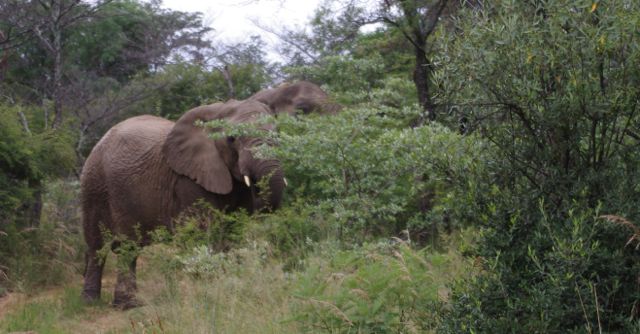It was my first time in Africa since leaving Ethiopia 50 years ago. We’ve both changed.
A whirlwind week in an unfamiliar country – let alone an unfamiliar continent – doesn’t make you an expert. At best, it leaves you with some vivid impressions. Especially if you get out of our all-too-usual routine of airports, hotel meeting rooms, and fellow expats.
My first trip to South Africa was indeed well out of my routine. Thanks to my wonderful colleagues at ERM in South Africa, my first 24 hours in the country included elephants, zebras, giraffes, warthogs and other non-routine meetings. My last 24 hours included hiking atop Table Mountain, baboons staring down cars, the Cape of Good Hope, townships, seals playing in the surf, and brilliant ocean vistas. In between, I had the chance to meet with 30 clients from across South Africa. They came from diverse sectors, from mining to medicine, chemicals to communications, resources to retail. We met (admittedly) in hotel meeting rooms in Johannesburg and Cape Town, but also in mine offices and company canteens. I also had in-depth conversations with a dozen colleagues from ERM’s South African business unit, the base for a growing presence throughout Africa.
That left me with two vivid impressions. Both are about sustainability, one more emotional and the other more intellectual.
The emotional impression is a pretty typical reaction to Africa, I’m told: overwhelming beauty, scale and complexity mixed with constant reminders of the power of nature. I don’t have the words to do justice to this, so I’ve just bored family and friends with pictures.
The intellectual impression is of a sustainability laboratory: all the issues are in play here. There are no constants. Social, economic and environmental factors are all in flux and interconnected. South Africa as a society and an economy, is like a big extended family sharing a house that’s too small and needs work. People are already living on the ground floor, some are working to expand the house and add rooms and comfort to the second floor, while others are still working to shore up the foundation. Logically, you would work on the foundation first. But there’s not time for that, the house is already too crowded and the expectations about the growth too high. In fact, the excitement and demand for those additions to the house provide the very energy and resources needed for shoring up the foundation. Neither task, additions or foundation, can wait for the other to go first.
The biggest question is, can this work? Can this country grow sustainably? Sustainable development isn’t an interesting question here, it’s an imperative. It is, in effect, the elephant in the room. That elephant isn’t exactly hidden; everyone knows it’s there, once you know where to look.
“That elephant isn’t exactly hidden” – Mabula Game Lodge, Limpopo, South Africa
Fortunately, I had a great teacher who showed me what to look for. For all the terrific insights from clients and colleagues, my best teacher was July, the ERM driver who took me from Johannesburg out to the bush. July, it turns out, is studying environmental management. He is energetically turning potential burdens into opportunities. He is reveling in the moment. And he taught me how to listen to South Africa.
- His day job is as a driver, taking people to and from meetings about environment and sustainability. A source of distraction and frustration to someone studying for a better career? No, a source of opportunity to get experience: he won approval to go into meetings and sit in the back taking notes rather than sitting outside in the car.
- He grew up with parents from two different clans speaking different languages (Northern Sotho and Tsonga). With Afrikaans and English both used in school, he had to learn four languages by the time he was eight. A source of confusion and burden? No, the source of a facility with languages which he’s now using to learn Portuguese so he’ll be prepared for the growth markets on South Africa’s borders. And he’s making sure his children learn multiple languages.
- Stuck spending a Saturday driving this American through drenching rain nearly flooding the streets of Bela Bela? He deftly turned it into a mutual coaching session. We spent hours in the car and over lunch in a fair trade of experience. He extracted lessons in consulting and client service from me. He gave me powerful lessons in South Africa’s true sustainability challenge: meeting economic, infrastructure and social needs amidst vulnerable environmental riches and growing expectations.
July didn’t just drive my travel-weary body that day, he drove my understanding. Just like he’s driving his career. And it’s energy, insight and adaptability like his that helps give South Africa real promise for working through its sustainability challenges.
[Scott Nadler is a Senior Partner at ERM. To share this post, see additional posts on Scott’s blog or subscribe please go to snadler.com. Opinions on this site are solely those of Scott Nadler and do not necessarily represent views of those quoted or cited, ERM, its partners or clients.]



Mr.Livingston I presume?
Even the more sofisticated Americans and Europeans of the 21st century keep looking at Africa as the place to watch its wilderness and enjoy the beauty of its diversity.
For my personal stupidity and lack of organization in my twelve trips to Africa (five of which were in the Austral emisphere) I never succeded in meeting an elephant or a lion and therefore my most vivid memories are about youth, drive to growth and energy of the people I met there.
Which matches well with Scott’s experience with his driver and inspirer July but also raises questions about the sustainability of the rightly increasing aspirations of the fastest growing and poorest population of the world.
Which level of poverty is sustainable to make sustainability affordable?